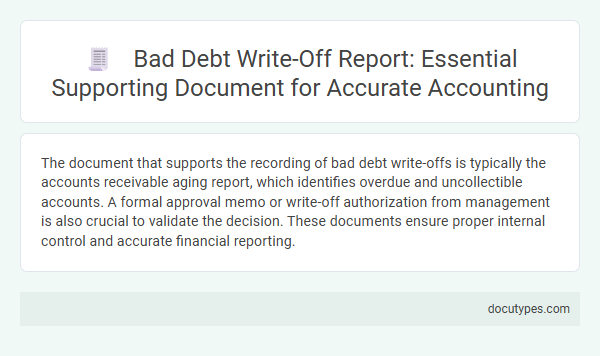The document that supports the recording of bad debt write-offs is typically the accounts receivable aging report, which identifies overdue and uncollectible accounts. A formal approval memo or write-off authorization from management is also crucial to validate the decision. These documents ensure proper internal control and accurate financial reporting.
Introduction to Bad Debt Write-Off Reports
Bad debt write-off reports document the process of removing uncollectible receivables from accounting records. These reports validate the financial impact of bad debts and support accurate financial reporting.
- Bad Debt Write-Off Report - This report itemizes accounts deemed uncollectible and justifies their removal from receivables.
- General Ledger - Reflects adjustments made for bad debt write-offs within financial statements.
- Accounts Receivable Aging Report - Highlights overdue accounts that may qualify for bad debt write-offs.
Importance of Accurate Write-Off Documentation
| Document Type | Description | Role in Bad Debt Write-Offs |
|---|---|---|
| Bad Debt Write-Off Authorization Form | Formal approval document signed by management or finance officers. | Serves as official consent for removing uncollectible receivables, ensuring accountability. |
| Accounts Receivable Aging Report | Detailed report categorizing outstanding invoices by due date. | Identifies overdue accounts eligible for write-off evaluation. |
| Customer Correspondence | Communication records such as emails, letters, or collection attempts. | Provides evidence of collection efforts and customer negotiation outcomes. |
| Accounting Ledger Entries | Journal entries documenting the write-off transaction in financial records. | Records the impact of the write-off on financial statements and ensures accurate bookkeeping. |
Importance of Accurate Write-Off Documentation
Precise documentation supports compliance with accounting standards and regulatory requirements. It enhances transparency and facilitates audit trails, reducing the risk of financial misstatements. Proper evidence strengthens internal controls and supports management decisions regarding credit policies and risk assessment. Accurate records also contribute to reliable financial reporting, maintaining stakeholder trust and protecting organizational integrity.
Key Elements of a Bad Debt Write-Off Report
A Bad Debt Write-Off Report is essential for accurately documenting uncollectible receivables. This report supports the recording of bad debt write-offs by providing clear evidence of customer account statuses and company financial adjustments.
The key elements of a Bad Debt Write-Off Report include the customer's identification details, the outstanding invoice amounts, and the reason for the write-off. It also contains authorization from management, the date of write-off, and references to supporting documents like correspondence or collection attempts. These details ensure transparency, compliance, and proper accounting treatment.
Criteria for Identifying Bad Debts
The document that supports the recording of bad debt write-offs is the aged accounts receivable report. This report categorizes outstanding invoices by their due dates, enabling the identification of overdue accounts.
Criteria for identifying bad debts include the age of the receivable and the customer's payment history. Accounts that remain unpaid beyond the specified aging period and demonstrate no payment activity are typically classified as bad debts.
Required Supporting Documents for Write-Offs
Accurate documentation is essential for recording bad debt write-offs in financial records. Required supporting documents include the original credit agreement and detailed account statements showing outstanding balances.
Proof of collection efforts, such as correspondence or demand letters, also supports the validity of the write-off. You must retain these documents to ensure compliance with accounting standards and audit requirements.
Approval Procedures for Debt Write-Offs
The document that supports the recording of bad debt write-offs is the Debt Write-Off Approval Form. This form outlines the approval procedures required before you can proceed with writing off uncollectible accounts. It ensures that all write-offs are authorized by the appropriate management level, maintaining compliance and accuracy in financial reporting.
Impact of Write-Offs on Financial Statements
Which document supports the recording of bad debt write-offs? The Allowance for Doubtful Accounts schedule verifies the estimated uncollectible amounts. This document ensures accurate matching of expenses and revenues in the financial statements.
How do bad debt write-offs impact financial statements? Write-offs reduce accounts receivable and the allowance for doubtful accounts without affecting net income at the time of write-off. They reflect more accurate asset values and improve the reliability of the balance sheet.
Compliance and Audit Considerations
Proper documentation is essential for supporting the recording of bad debt write-offs to ensure compliance with accounting standards and audit requirements. You must maintain accurate records that demonstrate the validity and authorization of the write-offs.
- Authorization Documentation - Records such as approval forms or management sign-offs verify that bad debt write-offs are officially sanctioned.
- Customer Account Statements - Detailed account histories illustrate the debt's status and support the justification for write-offs.
- Correspondence Records - Communications with customers or collection agencies provide evidence of collection efforts before write-off.
Maintaining these documents enables your organization to meet regulatory compliance and withstand audit scrutiny effectively.
Best Practices for Managing Bad Debt Reports
Accurate documentation is essential for supporting the recording of bad debt write-offs and ensuring compliance with accounting standards. Maintaining detailed records enhances the reliability of bad debt reports and facilitates audit processes.
- Accounts Receivable Aging Report - This report identifies overdue accounts and helps justify bad debt write-offs by highlighting uncollectible receivables.
- Bad Debt Write-Off Authorization Form - A formal approval document that authorizes the write-off, ensuring internal controls and accountability.
- General Ledger Entries - Detailed journal entries that record the write-off, providing a clear audit trail for financial reporting and tax purposes.
Which Document Supports the Recording of Bad Debt Write-Offs? Infographic

